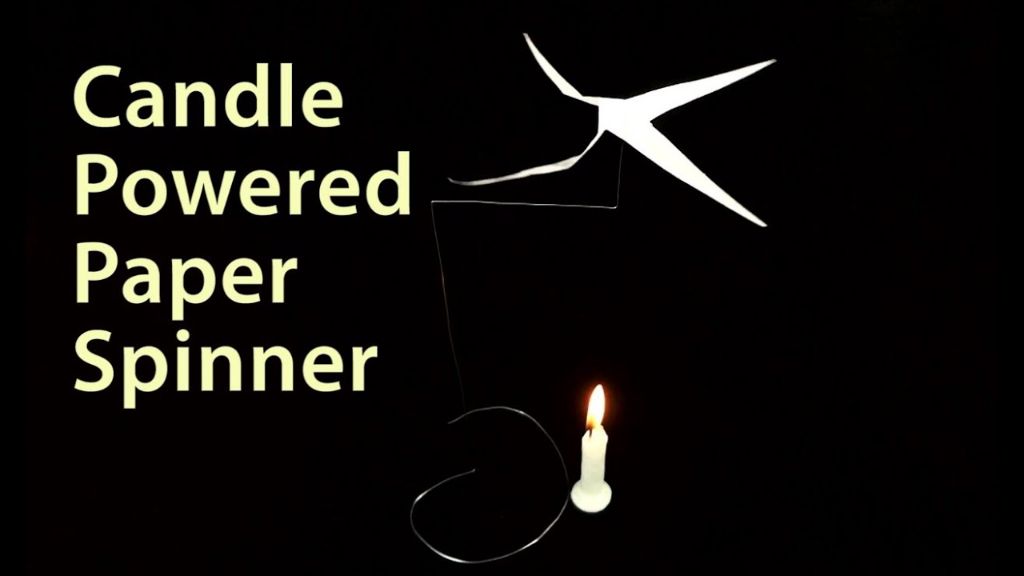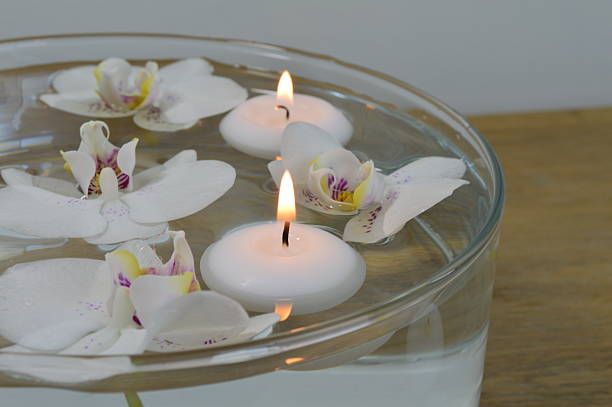What Happens To The Paper Turbine When It Is Placed Over A Candle?
Paper turbines are simple, fun science projects that demonstrate the power of basic physics principles. They are typically made by folding paper into a specific shape that allows them to spin when air passes over the blades. In this article, we will be exploring what happens when a paper turbine is placed over a lit candle.
The flame from a candle produces hot air that rises upward. This upward flow of warm air allows the paper turbine to spin. We will construct a basic paper turbine, light a candle, and observe the effect of placing the turbine over the flame. This interesting experiment will let us see firsthand how the physics of hot air and motion can set the paper blades spinning.
Materials Needed
To conduct this experiment, you will need the following materials:
- Paper – 1 sheet of 8.5×11 printer paper. Regular copy paper or something slightly heavier like cardstock works best.
- Scissors – For cutting out the paper turbine shape.
- A candle – Standard size birthday candles or votive/tealight candles work well.
- Matches or a lighter – To safely light the candle.
The paper and candle are the key components here. The paper will be cut and folded into the turbine shape that will spin when placed over the lit candle. Be sure to exercise caution when lighting and working near an open flame.
Constructing the Paper Turbine
To construct a simple paper turbine, you will need one sheet of paper or cardstock, scissors, a thumbtack, ruler, and pencil. Follow these instructions:
- Cut a strip of paper or cardstock that is 1 inch wide and 9 inches long. This will be the turbine blades.
- Take the strip and curl it into a loop shape, joining the ends together with tape to form a circle. Try to make the circle as even as possible.
- Make a second loop the same size as the first and cut it. This forms two rings.
- Lay the rings on top of each other and line them up neatly. Place the thumbtack through the center point to hold them together.
- Use scissors to cut from the edge of each ring to about halfway to the thumbtack. Make cuts every half inch or so. These will be the blades of the turbine.
- Fan out each blade gently so they stick out from the ring at an angle. Make sure they can spin freely.
- Poke the pin of the thumbtack through a pencil eraser to create a stand for the turbine.
You should now have a simple paper turbine that spins freely on top of a pencil when you blow on it. It’s now ready to be tested over the candle.
Lighting the Candle
When conducting any science experiment, it’s crucial to follow proper safety procedures. Here are the steps for safely lighting the candle used to test the paper turbine:
Step 1: Make sure there is adequate ventilation in the room and no flammable materials nearby. Choose a stable, flat surface like a table or countertop to place the candle.
Step 2: Read all warning labels on the candle packaging before opening. Check that the wick is centered and trimmed to 1⁄4 inch length before lighting.
Step 3: Have an adult present to supervise. Never leave a burning candle unattended. Keep lighters and matches out of reach of children.
Step 4: Light the candle away from any drafts or ventilation that could blow out the match. Use a long fireplace match or utility lighter. Hold the flame to the tip of the wick until it ignites.
Step 5: Let the candle burn for a minute before placing the paper turbine over it. This allows the wax pool to melt and the flame to stabilize.
By carefully following these candle lighting steps, you can safely perform the paper turbine science experiment.
Placing the Turbine
Once the candle is lit, the next step is to gently place the paper turbine over the flame. It is important not to drop the turbine straight down onto the flame. Rather, slowly lower it down until it is hovering just above the flame. The turbine should be as centered over the flame as possible, without actually touching it.
Take care not to let the paper edges dip down onto the flame, as this could cause it to catch fire. The turbine should be lowered until the rising heat of the candle flame causes it to start spinning. The goal is to position the turbine so that it can spin freely from the upward motion of the heated air, while avoiding any direct contact with the flame itself.
With a steady hand and a slow, gentle motion, position the turbine so it seems to almost float over the candle. The turbine will begin spinning faster as the warm air rises through its blades. Avoid sudden movements so the turbine doesn’t shift off-center or fall onto the flame. Patience here pays off with a smoothly spinning turbine harnessing the power of the rising warm air.
Observing the Effect
When the paper turbine is carefully placed over the lit candle, you will immediately notice that the turbine begins spinning rapidly. The flame generates hot air that rises steadily upwards from the candle. As this heated air reaches the bottom of the turbine, it provides the ‘lift’ needed for the turbine blades to catch the air and start spinning. Hot air is less dense than cool air, so it rises very quickly upwards from the flame. This creates an upward draft that keeps pushing the turbine blades to spin around the shaft. Depending on the size of the flame and turbine, the rate of spin can be quite fast. The turbine may reach several hundred or even thousands of revolutions per minute! It’s an impressive sight to see the turbine spin faster and faster until it is just a blur over the candle.
The Science Behind It
The paper turbine spins when placed over the candle due to basic principles of thermodynamics and fluid dynamics. Specifically, the heat from the candle flame causes the air above it to expand and become less dense than the surrounding air. This creates a region of lower pressure. The pressure difference causes the less dense, warmer air to rise, creating an updraft that acts upon the turbine’s blades and causes them to spin.

Additionally, as the turbine spins, it draws in surrounding cooler air towards the bottom. This aids in circulation and helps maintain the updraft. The turbine blades are specially shaped to capture this kinetic energy from the rising warm air and convert it into rotational motion. So the turbine essentially harvests energy from the convection currents caused by the candle heating the air.
The same principles of hot air rising and causing circulation apply to weather patterns and winds in the atmosphere. The spinning turbine serves as a model to demonstrate basic thermodynamics. By altering the materials and design, many scientific principles can be illustrated.
Variables that Affect Spin Rate
The spin rate of the paper turbine is affected by several key variables relating to the candle and the design of the paper turbine itself. The size and intensity of the candle’s flame impacts the updraft it creates, which directly influences the speed at which the turbine spins. Larger candles like votives or pillars create a more powerful updraft than smaller tea lights. This gives the turbine above them a faster spin rate.
The design of the paper turbine also affects its spin rate. The number of blades on the turbine impacts its rotational speed. More blades create more surface area to catch the updraft, but also more drag. There is a balance between blade number, surface area and drag that produces the optimal spin rate. The shape, length and angle of the blades also impact spin speed. Experimenting with different blade designs reveals which work best to catch the updraft from a candle.
The weight and sturdiness of the paper used is another factor. Heavier paper holds its shape better but creates more drag. Lightweight paper folds easily into blades but is more prone to wobbling or uneven spinning. Striking a balance here can maximize spin rate. Lastly, the overall diameter of the circular turbine base affects its spin. Larger diameters spin more slowly but have better stability, while smaller diameters allow faster spinning.
Experimenting with Designs
There are many ways to modify the paper turbine design to try to increase its spin rate and performance. Here are some ideas to try:
- Vary the number of blades – Add more blades to increase surface area exposed to the rising air.
- Adjust blade shape – Long, thin blades versus short, wide blades.
- Curve the blades – Curved blades act like airplane wings to provide lift.
- Change blade angle – Pointing blades upwards versus angled sideways.
- Balance the turbine – Make sure it spins evenly and doesn’t wobble.
- Modify base size – Wider base increases stability.
- Elevate the turbine – Raise it up on legs to reach faster moving air.
- Try different materials – Heavier paper holds shape better.
- Coat with wax paper – Repels heat better.
By testing out modifications, you can gain insight into which turbine designs generate the most spin. Just make sure to only change one variable at a time when experimenting.
Conclusion
This demonstration showed how a simple paper turbine can be propelled to spin using the rising hot air from a candle. When placed over the flame, the heat causes the air to rise rapidly through the turbine blades, generating lift and causing it to spin. Depending on the design, the turbine may reach high rates of rotation. This occurs due to the principles of convection and thermodynamics – hot air rises and flows upward, transferring kinetic energy to the turbine. Through experimentation with blade shapes, angles, and number, the spin rate can be optimized. This project provides an engaging way to explore concepts in physics, engineering, and design using common household materials. After constructing their own turbines, students can tinker and innovate to answer questions about what factors maximize spin rate. The trial and error process facilitates creative problem solving. Overall, this demonstrates how heat and air flow can be harnessed to generate motion and do useful work.




